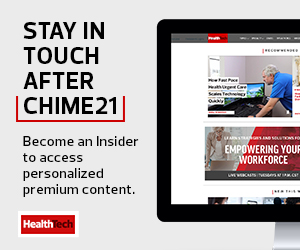Craig Richardville, chief innovation and digital officer at SCL Health, explains why the organization implemented Nuance Communication's Dragon Ambient eXperience technology.
To determine its first cohort of 25 provider users, SCL Health looked at signal data, a description of how each provider uses the system and where providers spent time within it. The team focused on people who were spending lots of time on documentation or who were doing documentation before or after work.
SCL Health has found more accurate documentation and more precise billing codes with the new technology. However, clinicians can access the recording from the cloud if they want to do quality assurance of the transcription. Richardville said a major benefit is that the technology is intuitive, not invasive, and patients may see it as modern within the healthcare environment.
He emphasized that the Nuance technology is not required. He said it’s important for a healthcare organization to determine whether the solution would be a provider expense or if the hospital would provide it to retain and recruit providers.
So far, SCL Health’s adoption rate is 60 percent within the first cohort, and Richardville said it saves each provider 60 to 90 minutes per day. As the program continues, he hopes more providers will adopt it and see its benefits.
SCL Health included a variety of practices and specialist types in the first cohort and found that adoption was higher among specialists, especially cardiology and orthopedics, than among primary care physicians. He thinks this stems from the more limited terminology used in specialties, and that primary care adoption may grow with time as the vocabulary expands.
RELATED: Find out why NLP could be a game changer for EHR workflows.
How the 21st Century Cures Act Affects Healthcare IT Leaders
“Imagine you got into a car accident and are being treated at a hospital you haven’t been to, where they don’t have your records, and you have a medical device that makes it so you can’t get an MRI,” said Donna Houlne, vice president and clinical officer at Infor. “Wouldn’t it be amazing if your records were already at that ER, and the clinicians knew your history and background without having to ask questions?”
That’s what interoperability can do — and what healthcare could look like soon.
In a CHIME21 digital session titled “Realized Interoperability: Who is Knocking at the Digital Front Door? Interoperability,” Houlne and Judy Murphy, former chief nursing officer for IBM Global Healthcare and former chief nursing officer and director of the Office of Clinical Quality and Safety at the Office of the National Coordinator for Health Information Technology (ONC), discussed why healthcare IT leaders need to start planning for increased operability.
Murphy explained that the ONC’s Cures Act Final Rule will require healthcare organizations to provide all health information to patients next year, and to facilitate an ecosystem of data flowing freely between providers. Currently, she said, a packet of data is sent from provider A to provider B, and that data is usually stored separately from patient data in the EHR.
“A clinician would have to go into the historic log in the electronic record to see the information,” Murphy said. “That’s outside the typical clinician workflow.”













